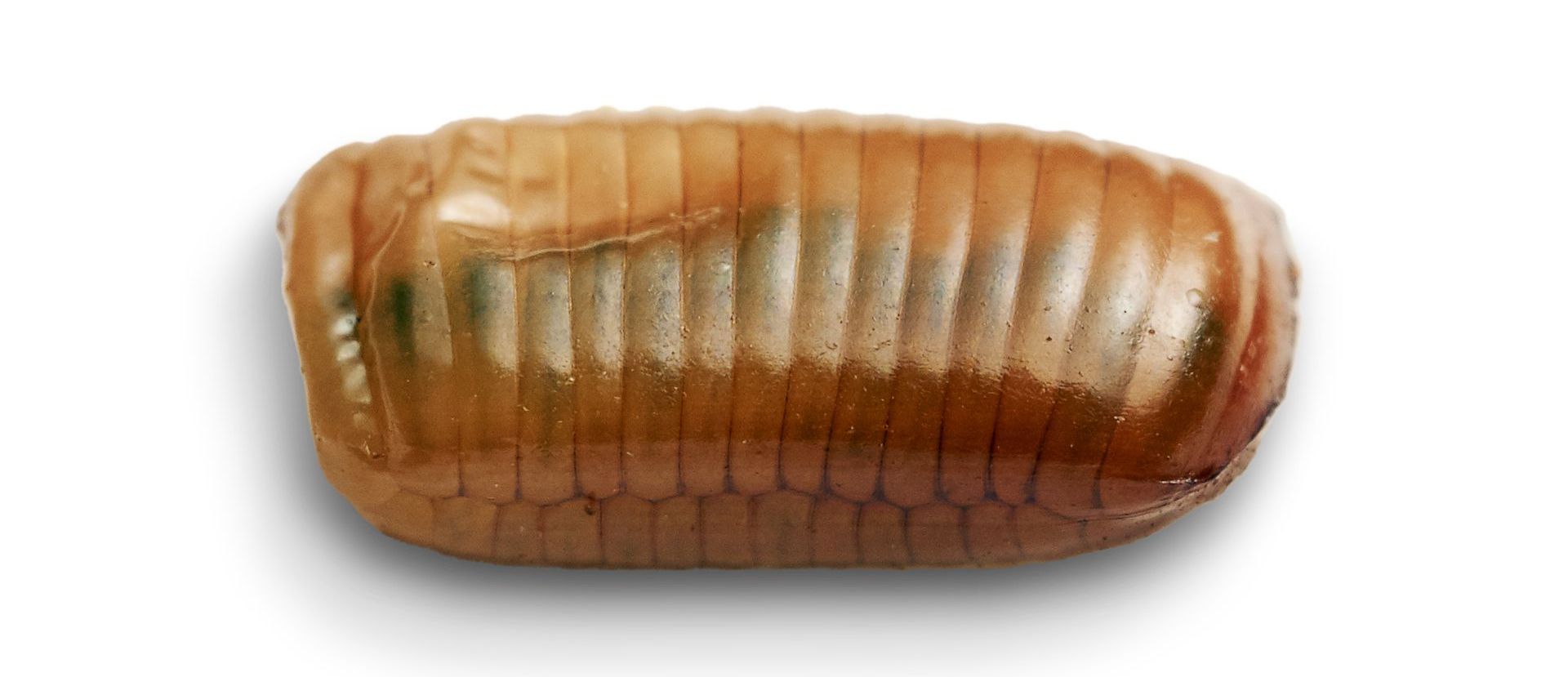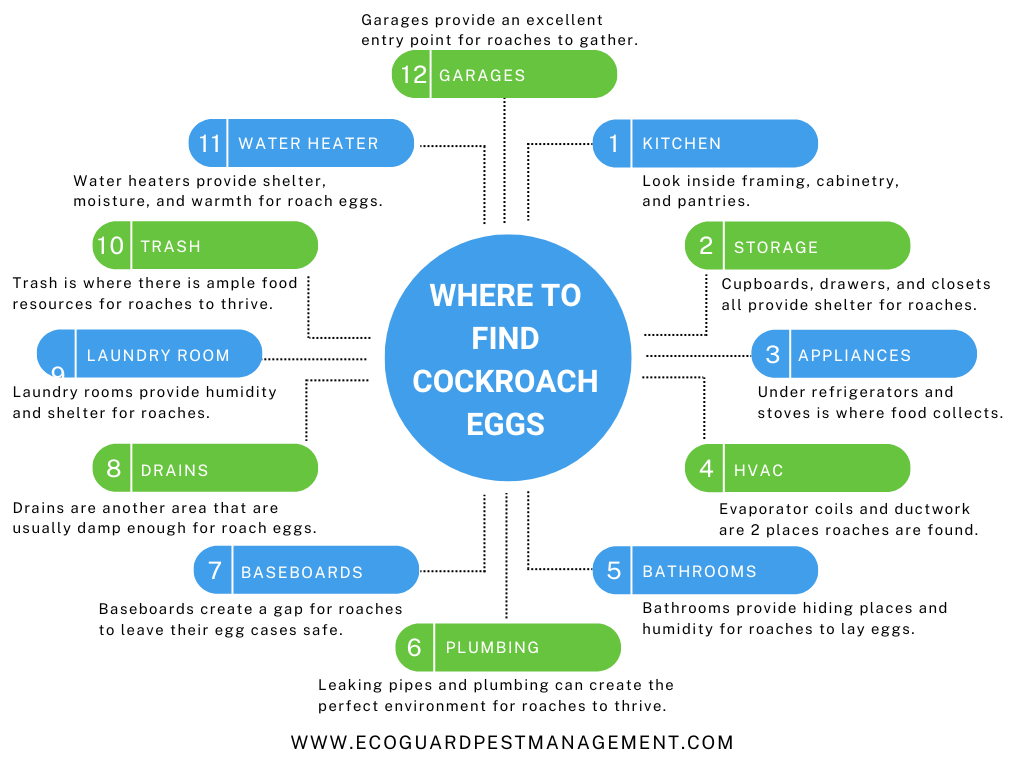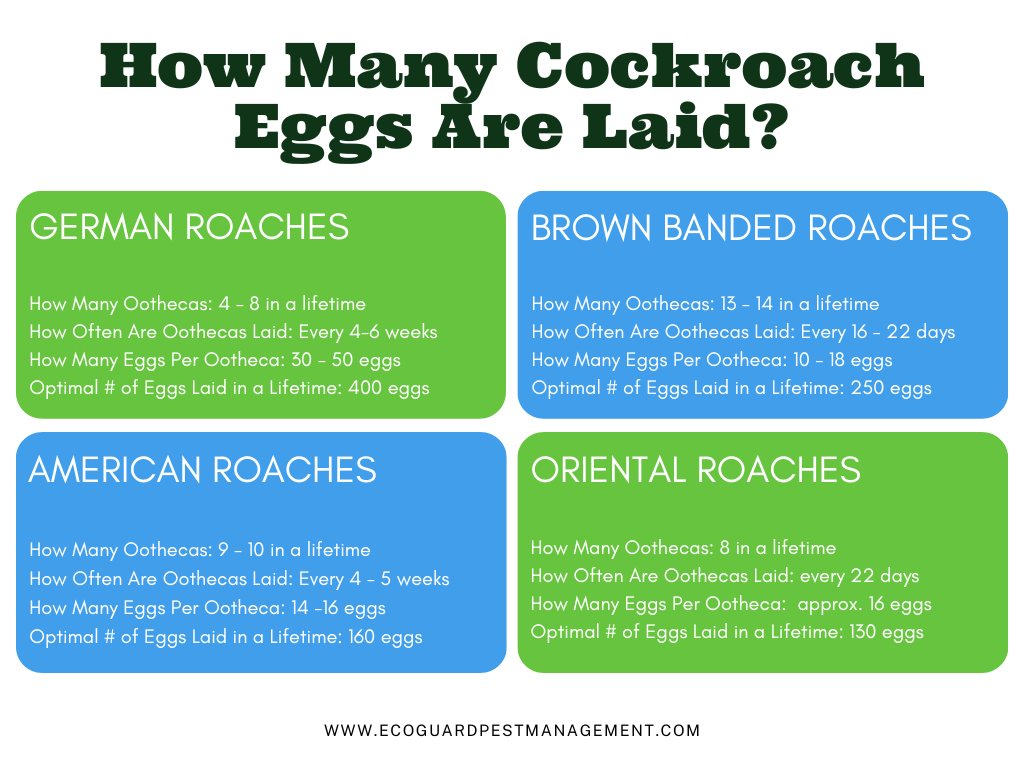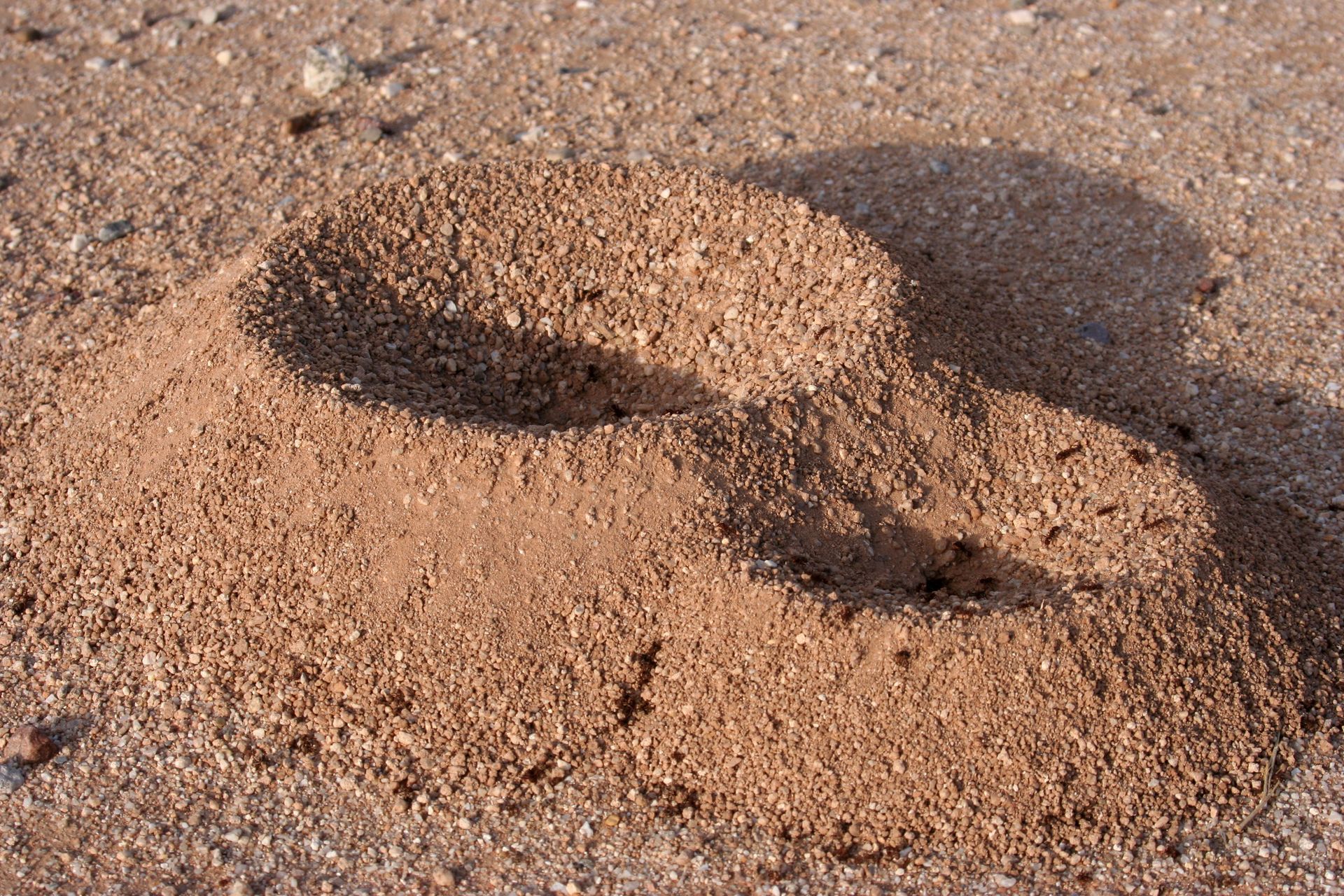Cockroach Eggs
How to Identify and Get Rid Of Cockroach Eggs

Female cockroaches lay eggs in clusters contained in hard sacs called oothecas. This is the reason that cockroaches can seemingly appear out of nowhere. One ootheca can hatch as many as 10 – 50 cockroach nymphs at a time. This can quickly become a problem that needs to be dealt with immediately to prevent an infestation. A clear increase in cockroach activity usually indicates that cockroaches are laying eggs which are producing larger numbers of new cockroaches. The presence of new cockroaches could also mean that there is a cockroach nesting site somewhere close by. This area should be treated to ensure that cockroaches are exterminated and then treated again in the following month to ensure that cockroaches that hatched after the original treatment are also killed.
What is a Cockroach Egg Case?
Most cockroaches do not produce individual eggs. Instead, they produce oothecas, which are hardened egg sacs, that carry between 10 - 50 eggs depending on the species of cockroach. Oothecas are typically deposited somewhere safe until the eggs hatch. Other times a cockroach may carry the ootheca up until a day or 2 before the eggs are ready to hatch.
What Do Cockroach Eggs Look Like?
Oothecas are unique to each species of cockroach, but they share many similarities. Most oothecas are smaller than 1 cm, looks a lot like a bean or seed, and are generally brown, red, or black. Most oothecas have a bumpy ridge along the side which is where the case will split open when the eggs are ready to hatch. After the eggs hatch and the cockroach nymphs force their way out of the ootheca, the hardened case will revert back to normal and appear sealed back up as if it still contains eggs.
What Do German Cockroach Eggs Look Like?
German cockroach egg cases are roughly 5/16 inch long, 1/8 inch thick, 5/64 inch wide in size, and light brown in color. They look like a little capsule with a hard ridge on one side.

What Do American Cockroach Eggs Look Like?
These egg cases are about 5/16 inch long and 1/5 inch thick. They can be anywhere from dark red to black and are usually stuck to a surface where the female deposits them.

What Do Brown Banded Cockroach Eggs Look Like?
Brown banded cockroach eggs cases are dark yellow to reddish brown. These oothecas are typically the smallest of the North American household cockroaches and measure only a 1/4 inch long.

What Do Oriental Cockroach Eggs Look Like?
Oriental cockroach egg cases start off a light yellow before turning reddish brown to brownish black. They are about ½ inch long making these egg cases one of the largest of the household cockroach species.

Where to Find Cockroach Eggs
Cockroaches are scavengers who eat everything so their egg cases can usually be found just about anywhere near ample resources like food and water. However, cockroaches are careful with where egg cases get deposited. Cockroaches will set the egg cases in places that will remain undisturbed until the eggs are ready to hatch. Places that cockroach eggs are commonly found include:
- Inside the kitchen counter framing, cabinetry, and pantry
- In the backs of cupboards and drawers
- Below and inside major appliances
- Under the AC evaporator or inside HVAC ductwork
- Under sinks
- Around leaks or other places where moisture exists
- Around or below baseboards
- Floor and bathtub drains
- Near laundry machine
- Trash cans
- Water heater closet
- Garages and outside

Where Do German Cockroaches Lay Eggs?
German cockroaches generally keep their egg cases attached to the body of the female cockroach almost all the way to the end of gestation. At the end, these cockroaches will release the egg case within a day of the eggs hatching and will sometimes even carry the eggs until they hatch completely. If they do release the egg case, it will be in a tight crevice where it is dark, humid, and warm, like near a loose pipe fitting.
Where Do American Cockroaches Lay Eggs?
American cockroaches will deposit their eggs sacs close to food so the nymphs that hatch from the eggs are able to find an immediate source of nutrition. They are carefully placed and attached to a surface using sticky saliva. These oothecas can be found in kitchen cabinetry, inside pantries, or under appliances like the refrigerator or stove.
Where Do Brown Banded Cockroaches Lay Eggs?
Female brown banded cockroaches only carry the ootheca for a day or two before they deposit it somewhere safe, dark, and warm. They are typically found clustered together in high up places with textured or rough surfaces like wood grain and walls. Unlike other cockroach species that generally stay low to the ground and near humid sources, brown banded cockroaches will attach their oothecas to shelves, ceilings, and other elevated spaces that are out of sight.
Where Do Oriental Cockroaches Lay Eggs?
Oriental cockroach eggs are extremely sensitive to temperature. In colder temperatures, the egg cases can take twice as long to hatch reducing the likelihood of survival. This means that oriental cockroaches will leave their eggs where there is ample moisture but also where there is a heat source that will keep the egg case warm. Look in water heater closets and in bathrooms for oriental egg cases because temperatures and humidity spike as hot water is used.
How Often Do Cockroaches Lay Eggs?
Cockroach populations can get out of hand quickly because of the short time it takes to reach maturity and their short reproduction cycle. The frequency at which cockroaches lay eggs can have a large impact on how fast an infestation grows.

How Often Do German Cockroaches Lay Eggs?
German cockroaches can produce a new egg case every 4 - 6 weeks with most German cockroaches producing between 4 – 8 egg cases during their cockroach life cycle.
How Often Do American Cockroaches Lay Eggs?
American cockroaches produce 9 – 10 egg cases in a lifetime which for American cockroaches is about a year long. This means that they are producing an egg case every month or so at the peak of their reproductive period.
How Often Do Brown Banded Cockroaches Lay Eggs?
Female brown banded cockroaches can produce approximately 13 -14 oothecas in their lifetimes if they are in an ideal environment. Temperature or humidity levels that are too high or low will have a significant impact on the rate and viability of brown banded cockroach oothecas. Adult brown banded cockroaches live on average between 205 – 315 days which means they are producing an ootheca every 16 – 22 days.
How Often Do Oriental Cockroaches Lay Eggs?
A female oriental cockroach can lay around 8 egg cases in their lifetime. Since an adult female oriental cockroach can live up to 180 days, this means that they can produce an ootheca roughly every 22 days upon reaching maturity.
How Many Eggs Do Cockroaches Lay?
The number of eggs cockroaches lay vary wildly depending on the environment the cockroaches live in and how long the cockroaches live. In ideal circumstances, some species of cockroach should be able to lay between 10 – 50 eggs at a time which over the lifespan of a cockroach can result in 160 – 400 eggs being laid.
How Many Eggs Do German Cockroaches Lay?
German cockroach oothecas will typically hold between 30 – 40 eggs in each case but can reach numbers as high as 50 per ootheca. This means that an individual female German cockroach can produce up to 400 eggs over the course of its life under ideal circumstances. German cockroach population growth is compounded by the fact that nymphs take a month to reach maturity and become able to produce oothecas of their own making the German cockroach one of most prolific cockroach species.
How Many Eggs Do American Cockroaches Lay?
American cockroach oothecas will usually contain between 14 – 16 eggs. This means that in a year, a female American cockroach can lay up to 160 eggs.
How Many Eggs Do Brown Banded Cockroaches Lay?
Brown banded cockroach oothecas can carry between 10 – 18 eggs. This means that one female brown banded cockroach can produce as many as 250 eggs in her lifetime.
How Many Eggs Do Oriental Cockroaches Lay?
Each oriental cockroach egg case normally holds around 16 eggs. One healthy female oriental cockroach can produce up to 130 eggs in her lifetime.
How Long Does It Take for Cockroach Eggs to Hatch?
The gestation period of cockroaches very wildly depending on the species of cockroach. Some reach viability in as quick as a month while others can take several months. The speed at which eggs hatch can also be impacted by environmental factors like temperature and moisture.
How Long Do German Cockroach Eggs Take to Hatch?
German cockroaches will typically hatch in about a month with ideal room temperatures and environmental conditions. Any fluctuations into colder or hotter temperatures will cause a delay in the expected time it takes for their eggs to hatch.
How Long Do American Cockroach Eggs Take to Hatch?
American cockroach eggs will typically hatch into nymphs in about 56 days. They are sensitive to temperature so any extremes will slow down the time it takes for these eggs to hatch.
How Long Do Brown Banded Cockroach Eggs Take to Hatch?
Brown banded cockroach eggs normal hatch time takes about 50 days. This can be delayed even further when temperatures drop below their ideal temperature range.
How Long Do Oriental Cockroach Eggs Take to Hatch?
Depending on the temperature, oriental cockroaches can take between 42 - 81 days to hatch. Optimal conditions will generally cause the hatch time for oriental cockroach to be around 45 days.
How To Get Rid of Cockroach Eggs?
Getting rid of cockroaches and their eggs will prove difficult because cockroaches deposit their egg cases where they are least likely to be found and disturbed. Not only that, but the ootheca will also protect the eggs from pesticide applications. If the egg cases are found, they can be safely removed and thrown out but be sure to crush the egg case to prevent the roaches from hatching in the trash. Since there is no great way to deal with cockroach eggs, it is best to ensure that treatment is applied that will exterminate the cockroach nymphs that eventually hatch. This requires residual pesticides and growth regulators combined with dusting to ensure that nymphs are treated with all 3 cockroach killers.
- Residual pesticides will remain after application so if nymphs come in contact with the poison, it will infect them causing them to die.
- Growth regulators will prevent the nymphs from developing into mature cockroaches.
- Dusting with borax or diatomaceous earth will destroy adult cockroaches’ exoskeletons while suffocating them and dehydrating their bodies.
Has That Cockroach Egg Case Already Hatched?
Finding cockroach egg cases is concerning but how do you know if it still contains eggs or not? Sometimes the ootheca will be split open and the eggs inside are gone. Other times, the egg case may have a seam opened along the hard ridge on the ootheca, but sometimes the ootheca close back up after the nymphs have exited making the ootheca still look viable. This makes it difficult to determine if the eggs have hatched. Usually, egg cases that are still viable are full and rigid. An egg case that has hatched will look dried out, shrunken, or dented. Regardless of if the egg cases have hatched, it is good to assume they are viable, remove them, and destroy them. Also be sure to look for other cockroach egg cases around any that you find since some species of cockroaches cluster their egg cases and other oothecas may be nearby.
Do Cockroaches Lay Eggs When Killed?
Cockroaches do not lay eggs when they are killed. This myth was likely started due to female cockroaches dying with oothecas inside or attached to their bodies. This would result in a viable ootheca hatching cockroach nymphs after the cockroach died. Unless the ootheca was damaged, the eggs are still viable and will hatch as if the ootheca was deposited somewhere safe. If the ootheca was damaged, crushed, or the eggs are exposed, then there is a good chance that the eggs will die.
Do Cockroaches Lay Eggs in Clothes?
Another common myth is that cockroaches lay eggs in human clothing. Yes, it is possible that cockroaches can lay eggs in clothing, but it is unlikely. If the clothes are in a place that remains undisturbed like boxed up in storage inside of a closet or garage, then there is a much higher likelihood of roaches laying eggs in those clothes. That said, cockroaches won’t deposit their egg sacs anywhere there is a chance that they will be disturbed or found. This means places like drawers, laundry baskets, and hampers are unlikely place for cockroach egg sacs. However, clothes that are stored away in closets that are left alone for long periods of time may have cockroach oothecas in them.
Contact EcoGuard Pest Management if You Have Seen Any Cockroach Eggs
If you have seen signs of cockroaches like cockroach egg cases, be sure to contact EcoGuard Pest Management. Egg cases are a sure sign that cockroach populations have started to multiply. This means it is a matter of time before you are dealing with a full-blown cockroach infestation. EcoGuard Pest Management uses an integrated pest management approach designed to deliver an effective
cockroach control & treatment strategy. Our customized plans ensure that cockroach problems are addressed immediately. Call today to schedule an inspection.

















